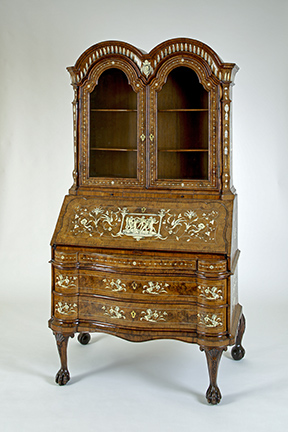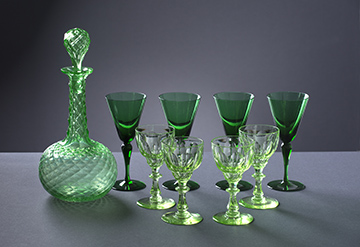The art of the useful
Unknown maker (Italy) ‘Grand Tour Fan’ 1790-1830, ivory with hand painted chicken skin, 1950/3/9. Collection of the Sarjeant Gallery Te Whare o Rehua Whanganui. Bequest of Miss F.J. Montgomery Moore, 1950
A hand-painted, “Grand Tour” chicken-skin fan; a large Cantonese vase rescued from a house fire; antique Italian furniture; Venetian glassware, silverware and ceramics old and new are among a glorious smorgasbord of decorative art works on show at the Sarjeant Gallery.
The exhibition, Function and Fancy – Decorative Arts from the Sarjeant Gallery collection and beyond is curated by Jennifer Taylor-Moore and displays rarely seen objects, both from the Gallery’s extensive collection and from two local historic houses, Lethenty in Bulls and Tōtarapuka homestead, now part of Acacia Park Motel on Anzac Parade.

Unknown maker (Italy) ‘Medici cabinet’ circa 1760, Italian walnut, 1927/1/2. Collection of the Sarjeant Gallery Te Whare o Rehua Whanganui. Bequeathed by Mrs W. J. Caccia- Birch, Marton, 1927
“We wanted to look at decorative arts within the Sarjeant collection and to bring out the origin of decorative art works. The term decorative arts refers to a wide variety of furniture, ceramics, metal-ware and textiles that were designed to be functional as well as pleasing to look at,” Ms Taylor-Moore said. “Decorative arts are traditionally viewed as having a slightly lesser status than fine arts such as painting, drawing and sculpture. Decorative art items were normally made to be used in the home so as well as bringing out art works from the collection we brought items in from actual known homes.”
Lethenty, a neo-Georgian style house, is still a family residence and was inherited by the late Hilary Haylock from her maiden aunts Jean and Nancy Wilson. Tōtarapuka homestead was built by Scottish settlers Andrew Duncan and his wife Margaret who arrived in Whanganui in 1841. It became a coach stop for horse-drawn carriages passing through Whanganui in the 19th century. The house was sold in 1972 and in 2008 the grand daughter Josephine Duncan bequeathed her personal effects and inherited objects to the Whanganui Regional Museum. Lethenty owners and the Museum have generously lent items for the exhibition.
The back-stories to some of the pieces are fascinating. The hand-painted fan, one of three displayed, is actually not chicken skin but rather a fine vellum, given a plucked feather effect. The follicle pattern was achieved by pressing seeds into cleaned, wet, untanned skins, sourced from very young sheep, goats and cattle. The skins were put under pressure and left to dry then the seeds were brushed away, leaving an imprint. The thin, delicate skins were more durable than silk and didn’t bleed when painted.

Selection of Lethenty glassware: Venetian wine glasses (dark green) circa 1970s, hand blown glass; Antique English wine glasses (apple green) circa 1830, cut glass; Glass decanter (apple green) cut glass. Collection of Lethenty. Courtesy of the late Hilary Haylock
The Cantonese vase is one of a pair that Jean Wilson rolled out of the fire, which destroyed the original Lethenty house in 1914. A new house was built in 1915. A cut glass decanter from Lethenty displayed beside a contemporary item from the Sarjeant collection shows how the designs of previously functional and decorative objects have influenced works now considered to be fine art objects in their own right. Two bowl forms by Whanganui ceramicist, Rick Rudd “make a beautiful homage to their functional origins but are not useful.”
A massive teapot and a jug by local potter, Ross Mitchell-Anyon are however both beautiful and fully functional.
“The exhibition shows the links and the blurring of distinction between the decorative and fine arts.”
The main exhibition will show in the i-Site gallery from 21 January while more environmentally sensitive items such as furniture will be displayed from 25 January at 38 Taupo Quay. “The i-Site gallery is flooded with natural light and there’s no temperature control so we had to choose objects that would not be affected by these environmental conditions. At the moment our exhibition space is quite limited compared to what will be available when we return to Queen’s Park. Once those [environmental] issues aren’t in the way we will have far more freedom to exhibit a greater breadth of the collection in a more fluid, flexible space.”
Helen Frances


